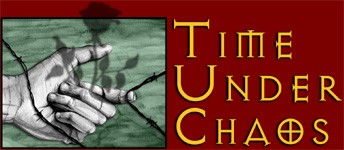
Seasonal RitesIndex | Time Under Chaos | Settings | Arden | Seasonal Rites In days gone by, when the world was much younger,
The first settlers of Arden brought with them from their home Shadows many legends and traditions. Among their traditions were the beliefs older than Time in the Lord and the Lady, the god and goddess that ruled Heaven and Earth and whose story could be followed in the movements of the heavens and the seasons. Though only snippets of their original faith remains, the Rites and Celebrations are still practiced today in Arden with much revelry and song. Because of the liberal consumption of alcohol during these celebrations, any hunting whatsoever is banned for everyone's safety. Violators are left staked and to the judgement of the haunted woods for one night. Survivors are prosecuted the next day. Julian has only had to enforce this a handful of times and thus began tales of the Warden's cruelty. Excerpts from the Booke of Common Knowledge, one of the ancient texts of Arden... Mid-Fall or Samhain is also known as November Eve, All Hallows, The Feast of Apples and The Feast of the Dead. This is the ending and the beginning of the Cycle of the Year. The days are getting shorter and the nights longer. This is the time in the Year when the Sun-God dies. But also there is the promise of Rebirth, for the Mother-Goddess is pregnant with the Sun-Child. Hecate traditionally stands over Samhain as the Keeper of the Caudron of Life, Death, and Rebirth. Hecate will guide the Old Sun-God to the Underworld to await Rebirth. The Mother-Goddess will sleep during this time to prepare for the Sun Child's Birth. This is a time to reflect, a time to rest, a time to embrace the silence of the Earth and contemplate the Mysteries of Death. Winter Solstice or Yule is the longest night of the Year. Mother-Goddess labors to birth the Sun-Child. Winter was a hard time for our ancestors. The Winter Solstice held the promise that the days were going to get longer, and that the Sun would return. Candles, bonfires and Yule logs are light to entice the Sun-Child back into the world. It is a time of Life, Joy and Celebration, for the Birth of the Sun-Child brought with it Life. Feasts, singing, and exchanging gifts have been a tradition at Winter Solistice. Mid-Winter or Candlemas is also called Imbolc, Lupercalia, The Feast of Pan. Imbolc mean "ewes milk" this is the time of year when ewes are pregnant with the first lambs of spring and are lactating. Lupercalia and the Feast of Pan centered around goats, but the concept of fertility is still the same. The days begin to get longer and people prepare for the first planting. This is when the Goddess has reawakened as the Virgin-Goddess and young Sun-God begins to grow in strength. The young couple explore sexuality and fertility at this stage of their growth. This is traditionally a time of cleansing. The last of the Yule decorations are burned and the house is cleaned. Spring Equinox or Ostara, the first day of true spring, the day and night hours are even. The young God, as Green Man, directs the animals to multiply and the Goddess incourages the fields to do the same. The name Ostara is derived from the name of the ancient lunar Goddess, Eostre. Her chief symbols were the bunny, both for fertility and because her worshippers saw a hare in the full moon; and the egg, symbolic of the cosmic egg of creation (also known as Eros). Ostara, along wtih her helpers, would refertilize the world with colorful miniature "cosmic eggs". Beltane is when the days get longer and the Young God emerges into Manhood. The God and Goddess fall in love and the Goddess becomes pregnant with the Sun-Child who will be born at Yule. In the old lands, young lords and ladies would rise before the sun, pair off into couples and go into the forest and gather things to make a Maypole. It is said that these couples would consumate before emerging from the forest, this is where the old term "a-maying" comes from. Maypoles are erected to symbolize the connection between the Sun and the Earth. Dancing around the Maypoles is said to make it easier for women to become pregnant. A May King and May Queen are choosen to represent the God and Goddess to watch over the festivies. Summer Solstice is the longest day of the Year and the height of the Rule of the Sun-King. Bonfires are lit. Dancing, singing and rejoicing of all kinds to celebrate the happiness of the bounty of the Earth and the life the Sun gives. Jumping over the bonfire is said to bring good luck, purification, fertility, health and love. Any type of music and merry making is encouraged. It is a good time for any type of magic Lammas or The First Harvest or Feast of Home, when the days are getting shorter and the nights longer. The Sun-King is getting older and prepares for the next cycle of Life to come. And people prepare for the final harvest by storing food and by slowing down from the hectic summer. Autumn Equinox or Mabon or the Final Harvest, when day and night are even again. The Goddess freely gives up Her bounty that is in the fields. The feasting and celebration are in thanks for that bounty and the life the Sun-God gave. The God, now the Wise Old Man, knowing the next cycle is to come, shortens his hours for he is dying. The Goddess, full of sadness for the Sun's coming death and the happiness of the coming birth, will rest. Thanks giving feasts are held; dancing and singing are common. It is a time to prepare for the stillness to come. Will you come with me?
|